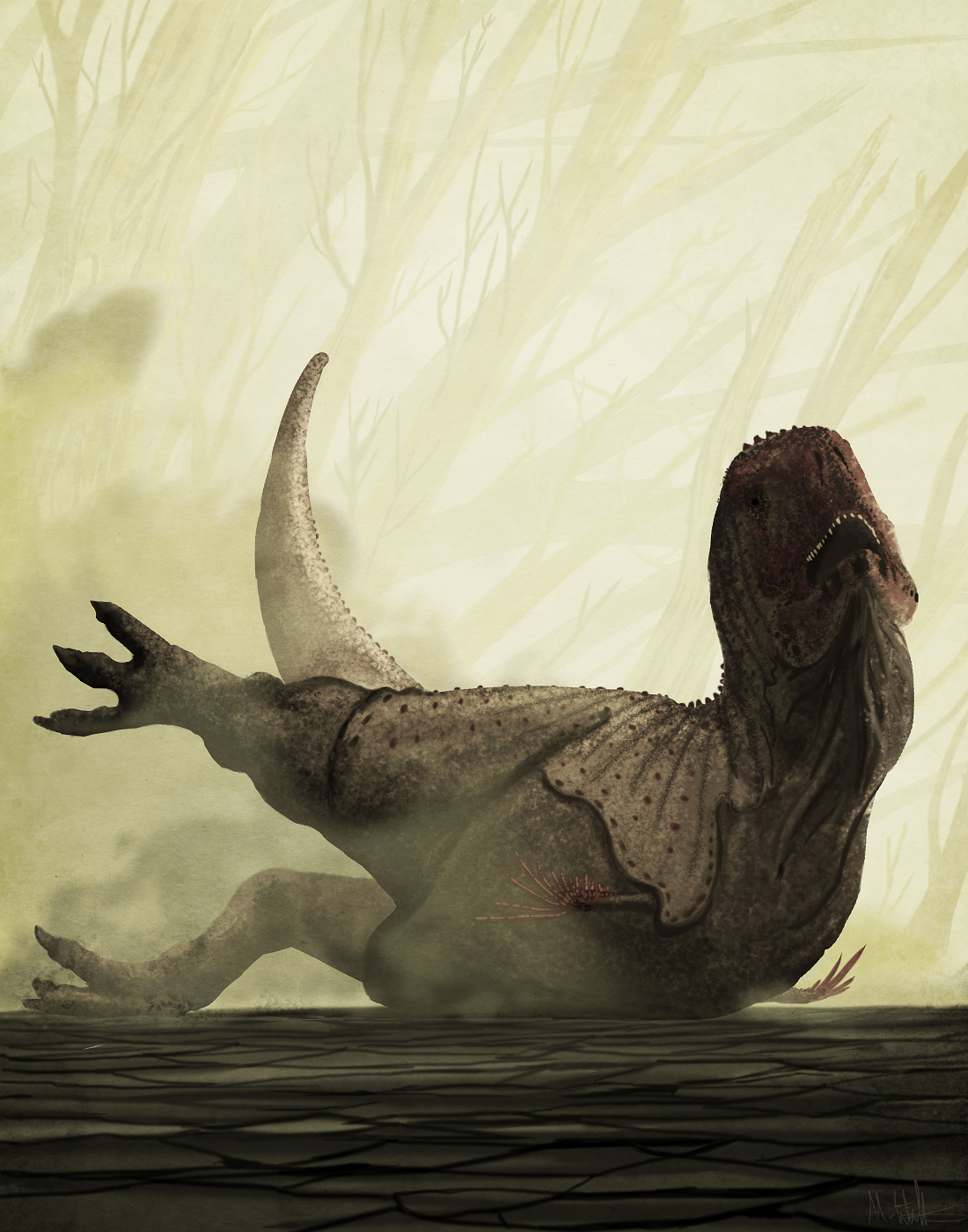 |
| Aucasaurus made a note in its diary after this. Simply said: "Bugger". Prints are available. |
In southern continents, abelisaurids remained medium-to-large sized predators. It was one of these, the Campanian, Patagonian species Aucasaurus garridoi that Felix Bridel asked me to paint as one of my £100 palaeoart commissions. Aucasaurus is one of the best known abelsisaurids, the holotype skeleton presenting an almost complete osteology of this c. 5 m long animal, and is considered a 'derived' member of the abelisaur clan. Its anatomy is almost as unusual as that of its close relative Carnotaurus. Like other abelisaurids, the general bauplan of Aucasaurus was that of a small head, tiny arms and relatively gracile torso strapped to a robust, probably powerfully muscled hindlimbs and tail. The peculiar anatomy of derived abelisaurid proximal tail vertebrae created huge spaces for hindlimb muscle-anchorage and likely betrays tremendous sprinting power (Persons and Currie 2011). Perhaps this explains the strange upper-body anatomy of abelisaurids: their gracile bodies and reduced extremities may represent pressures to keep weight down and speeds high. Long term readers may reconcile some components of this functional complex with another group of dinosaurs, the ornithischian clade Dryosauridae, which also married a powerful set of legs with a svelte upper body.
Felix wanted to incorporate the notion that Aucasaurus and similar species were probably fast runners into his commission, but not in a conventional way. While recent research has hinted that abelisaurids were likely fast, they were likely not as agile as other taxa. Bulging abelisaurid hindlimb muscles may have created a lot of power, but they also kept the tail base rather immobile (Persons and Currie 2011). In tight turns, the tail probably fairly ineffective for adjusting gravity centres or resisting turning inertia. Felix wanted his Aucasaurus image to reflect this, showing a predator which had overcooked its pursuit of a more nimble prey item and lost balance altogether. I was more than happy to oblige: watching animals for any length of time reveals they are just as clumsy as we are, but we seldom see palaeoart reflecting this. Perhaps the only exception is predators being thwacked by the weapons of their prey, which I guess sort of reflects a clumsiness, but it's not quite the same level of slapstick as an animal slipping over.
My brief working time with Felix was a lot of fun: it was clear from our first few emails that we had a similar idea in mind and the image came together quickly. I posted my progress of the image up on Twitter and, as you can see below, the basics of the image weren't altered from the start. Efforts were made to show the Aucasaurus mid-slip: deep enough into the fall for some immediate reaction to show, but early enough that the limbs and dust still have to settle. To my mind, the animal's right leg flew out from beneath it when attempting a tight left-turn, leaving it to gaze off-canvas at whatever prey item it was pursuing.
WIP clumsy Aucasaurus. All that speed, no maneuverability. Another £100 palaeoart deal. pic.twitter.com/jfPlqezmyM
— Mark Witton (@MarkWitton) November 28, 2014 Next stage of clutzosaurus: getting some highlights and shadows on there. No more time on him this evening, alas. pic.twitter.com/X5ofTvfV8P
— Mark Witton (@MarkWitton) November 28, 2014The controversial 'Nelson Muntz niche' was occupied by small maniraptorans in the Late Cretaceous. WIP Aucasaurus. pic.twitter.com/Yy20aQ6CXK
— Mark Witton (@MarkWitton) December 2, 2014Pending client approval, this image is ready to roll. A bit like the starring Aucasaurus, I guess... pic.twitter.com/6HZVt311jo
— Mark Witton (@MarkWitton) December 4, 2014That final Tweet did indeed feature the finished version (also seen at top), which is now being printed and packaged for delivery (click here if you would like your own copy). As usual, there's a lot more to say, but I'll have to end there. Before I go, a few nods are needed as goes sources for the picture: Scott Hartman's Aucasaurus skeletal was an important reference, as was the Coria et al. (2002) description of the Aucasaurus holotype. The notion that abelisaurid arms were used as display structures (termed 'pom pom arms' by @Blackmudpuppy) isn't new: All Yesterdays (Conway et al. 2012) explored that first.References
- Conway, J., Kosemen, C. M., & Naish, D. (2012). All Yesterdays: Unique and Speculative Views of Dinosaurs and Other Prehistoric Animals. Irregular Books.
- Coria, R. A., Chiappe, L. M., & Dingus, L. (2002). A new close relative of Carnotaurus sastrei Bonaparte 1985 (Theropoda: Abelisauridae) from the Late Cretaceous of Patagonia. Journal of Vertebrate Paleontology, 22(2), 460-465.
- Persons IV, W. S., & Currie, P. J. (2011). Dinosaur speed demon: the caudal musculature of Carnotaurus sastrei and implications for the evolution of South American abelisaurids. PloS one, 6(10), e25763.